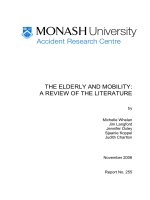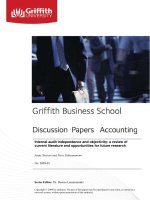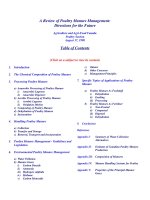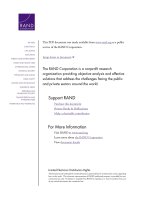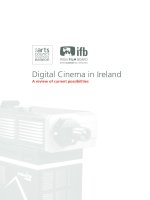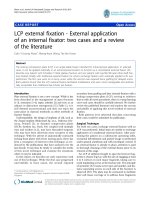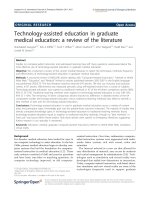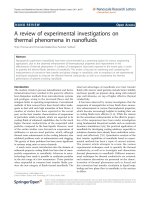Internal audit independence and objectivity: a review of current literature and opportunities for future research ppt
Bạn đang xem bản rút gọn của tài liệu. Xem và tải ngay bản đầy đủ của tài liệu tại đây (436.91 KB, 38 trang )
Internal audit independence and objectivity: a review of
current literature and opportunities for future research
Jenny Stewart and Nava Subramaniam
No. 2009-01
Series Editor: Dr. Dawne Lamminmaki
Copyright © 2009 by author(s). No part of this paper may be reproduced in any form, or stored in a
retrieval system, without prior permission of the author(s).
INTERNAL AUDIT INDEPENDENCE AND OBJECTIVITY: A
REVIEW OF CURRENT LITERATURE AND OPPORTUNITIES
FOR FUTURE RESEARCH
Jenny Stewart
Griffith Business School
Griffith University, Queensland, Australia
and
Nava Subramaniam
Faculty of Business and Law
Deakin University, Victoria, Australia
ABSTRACT:
This paper reviews the recent European and international literature on i nternal audit
independence and objectivity. We focus on s tudies involving internal auditors that
have been undertaken since the Institute of Internal Auditors’ revised definition of
internal audit in 1999. The topics we examine are the internal auditor’s dual role as a
provider of both assurance and consulting activities, the organizational status of
internal audit, internal audit’s involvement in risk management, outsourcing and cosourcing of internal audit activities and the use of internal audit as a training ground
for managers. Following our review of each of these topics, we discuss opportunities
for further research.
March 2008
INTERNAL AUDIT INDEPENDENCE AND OBJECTIVITY: A
REVIEW OF CURRENT LITERATURE AND OPPORTUNITIES
FOR FUTURE RESEARCH
Introduction
Auditor independence and objectivity are the cornerstones of the profession. The
assurance services provided by auditors derive their value and credibility from the
fundamental assumptions of independence of mind and independence in appearance.
Prior research on a uditor independence and objectivity has been undertaken
predominantly in the context of external audit. However, in more recent years, there
has been heightened interest in issues associated with the independence and
objectivity of internal audit. The motivation for research growth in the area is related
to the evolving and expanding role of internal audit as a key corporate governance
mechanism as well as an internal consultancy service. In this regard, internal auditors
are in a unique situation as providers of both assurance services within the
organization and consultancy services to managers. Not surprisingly, this dual role
has generated significant debate as it has the potential to place the internal auditor in a
situation of conflict. Furthermore, as employees of the organization, the ability of
internal auditors to exercise true objectivity has also been questioned (Paape, 2007).
In recognition of the potential for conflict, the Institute of Internal Auditors (IIA) has
issued a number of professional standards and guidelines with respect to
independence and objectivity. In fact, in 2001 the IIA published “Independence and
Objectivity: A Framework for Internal Auditors” (IIA, 2001) as a guide for managing
threats to objectivity. The framework identifies seven key threats: self-review, social
pressure, economic interest, personal relationship, familiarity, cultural and cognitive
biases. It also identifies a variety of safeguards against these threats.
The objective of this paper is to provide a review of the evolving literature on internal
audit objectivity in order to highlight gaps in knowledge and make recommendations
for future research. As a basis for our review, we draw on t he current definition of
internal audit promulgated by the IIA, together with the guidelines and standards on
independence and objectivity. Our focus is on the literature in this area since the new
definition of internal auditing was released in 1999.
3
Prior literature reviews of internal audit
To date, there have only been a limited number of prior reviews of the internal audit
literature. Bailey, Gramling and Ramamoorti (2003) edited a monograph published by
the IIA Research Foundation on r esearch opportunities in internal auditing. There
were two key objectives of this monograph. It was intended, first, to inspire academic
research on t opics of relevance to internal auditing and, second, to bridge the gap
between academics and practitioners. As such, it is a b lend of theory and practice,
designed to familiarize academic researchers with internal audit practice (Editorial
Preface, xi – xii). Each chapter of the monograph raises a series of research questions
related to a specific topic in internal auditing and we refer to these where relevant.
Gramling, Maletta, Schneider and Church (2004) examined the literature and future
research opportunities relating to the role of the internal audit function in corporate
governance. These authors focused on the relationship between internal audit and the
other cornerstones of governance (i.e. external auditors, the audit committee and
management). They also evaluated the literature on internal audit quality (including
objectivity and independence). However, much of the research cited relates to
external auditors’ evaluations of internal audit quality and on external auditors’
reliance on the work of internal audit. The authors provide an excellent synthesis of
the literature in this area, largely from a North American perspective. Hence, in this
paper, we concentrate on research relating directly to internal auditors and the internal
audit function, particularly focusing on studies from other parts of the world.
In 2006, the IIA commissioned the 2006 Global Common Body of Knowledge study,
engaging researchers from around the world “to better understand the expanding
scope of internal audit practice” (Cooper, Leung and Wong, 2006). An initial phase of
this study has resulted in three related literature reviews. Cooper et al. (2006)
examined the internal auditing literature in the Asia Pacific region, Hass,
Abdolmohammadi and Burnaby (2006) studied the literature from the Americas,
while Allegrini, D’Onza, Paape, Melville and Sarens (2006) performed a similar
review of the European literature. The purpose of these reviews was to document
changes in internal audit as a result of shifts in global business practices. Where
relevant, we draw on aspects of these studies that relate to internal audit objectivity.
4
Background - professional guidance relating to independence
and objectivity
In this section we review the professional guidance pertaining to internal audit
independence and objectivity. We commence with the definition of internal audit put
forward by the IIA (1999). We then summarize the IIA Code of Ethics (2000) with
respect to objectivity. We follow this with an overview of the professional standards
and other guidance that the IIA has issued on independence and objectivity.
The IIA (1999) definition of internal auditing is now familiar and well accepted:
“Internal auditing is an independent, objective assurance and consulting
activity designed to add value and improve an organization’s operations. It
helps an organization accomplish its objectives by bringing a systematic,
disciplined approach to evaluate and improve the effectiveness of risk
management, control, and governance processes.”
This definition highlights the independence and objectivity of internal auditing with
respect to both assurance services and consulting. Independence and objectivity are
closely related and are sometimes used within the IIA Standards in a somewhat
circular manner. Indeed, the IIA (2001) acknowledges that the terms have been used
interchangeably and with a l ack of clarity.
However, the Glossary to the IIA
Standards distinguishes between the two concepts in the following way:
“Independence – The freedom from conditions that threaten objectivity or the
appearance of objectivity. Such threats to objectivity must be managed at the
individual auditor, engagement, functional and organizational levels.”
“Objectivity – An unbiased mental attitude that allows internal auditors to
perform engagements in such a manner that they have an honest belief in their
work product and that no significant quality compromises are made.
Objectivity requires internal auditors not to subordinate their judgment on
audit matters to that of others.”
Hence, the IIA distinction between the two terms appears to be that objectivity is a
state of mind while independence is the state of affairs that permits an internal auditor
5
to operate with an objective attitude.
While the IIA standards emphasize
independence at the organizational level, the definition indicates that it is also
important at the individual, engagement and function levels.
The IIA Code of Ethics consists of a number of basic principles which internal
auditors are expected to uphold, together with rules of conduct which describe the
norms of behaviour expected of internal auditors. The principle relating to objectivity
requires internal auditors to “exhibit the highest level of professional objectivity in
gathering, evaluating, and communicating information about the activity or process
being examined.” Furthermore, internal auditors are expected to make a b alanced
assessment of all the relevant circumstances and they should not be unduly influenced
by their own or others’ interests when forming judgments. T he rules of conduct
specify that internal auditors:
(i) shall not participate in any activity or relationship that may impair or be
presumed to impair their unbiased assessment;
(ii) shall not accept anything that may impair or be presumed to impair their
professional judgment;
(iii)shall disclose all material facts known to them that, if not disclosed, may
distort the reporting of activities under review.
The IIA has issued a number of attribute standards and associated advisory statements
relating to independence and objectivity. Standard 1100 states that “the internal audit
activity should be independent, and internal auditors should be objective in
performing their work.” The related Practice Advisory 1100-1 indicates that
independence allows internal auditors to be impartial and unbiased in the exercise of
judgment and is achieved through organizational status and objectivity.
Attribute standard 1110 discusses organizational independence based on the chief
audit executive (CAE) reporting to a level in the organization that permits the internal
audit activity to fulfill its responsibilities. The various practice advisory statements
relating to this standard stress that the CAE should ideally report functionally to the
audit committee (or the board) and administratively to the chief executive officer
(CEO). As a minimum, administrative reporting should be to an executive with
6
sufficient authority to promote independence and provide the internal audit function
with the appropriate stature and status in the organization.
Attribute standard 1120 relates to individual objectivity and requires internal auditors
to “have an impartial, unbiased attitude and avoid conflicts of interest.” The related
Practice Advisory statement stresses the need to avoid potential and actual conflicts of
interest and bias at the individual level. The statement suggests that staff assignments
should be rotated periodically and highlights the importance of not accepting fees,
gifts or entertainment from their audit clients. Attribute Standard 1130 discusses the
need to adequately disclose to appropriate parties any impairment to independence or
objectivity. Examples of impairment discussed in implementation standards include
internal auditors assessing operations for which they were previously responsible.
Other impairments noted (in the Glossary to the Standards) are personal conflicts of
interest, scope and resource limitations, and restrictions on a ccess to records,
personnel and property.
Practice Advisory 1130.A1-1 does not permit staff
transferred or temporarily assigned to internal audit to undertake audits of activities
that they previously performed until at least one year has elapsed.
In addition to the standards and advisory statements, we noted earlier that the IIA has
also published a framework to guide internal auditors with respect to objectivity (IIA,
2001). T his framework requires internal auditors to identify, assess and manage
threats to their objectivity, including the need to consider safeguards that can mitigate
the effects of the threats. A n excellent summary of this framework is provided by
Mutchler (2003) 1 in her discussion of research opportunities related to this
framework. T o avoid duplication, we only provide an overview of the framework
while, in subsequent sections of the paper, we extend and discuss Mutchler’s
suggestions for research in the area.
On an individual level, the framework discusses seven threats to an internal auditor’s
objectivity. These are (i) self-review, where the internal auditor reviews his/her own
work; (ii) social pressure, where the internal auditor is exposed to pressure from, say,
the auditee, or others on the audit team; (iii) economic interest, resulting, for example,
from incentive payments or from auditing the work of someone who has the power to
affect the internal auditor’s employment or salary; (iv) personal relationship, where
1
This work comprises Chapter 7 of Bailey et al. (2003).
7
the internal auditor is a relative or friend of the auditee; (v) familiarity, resulting from
a long term relationship with the auditee including having worked in the unit being
audited; (vi) cultural, racial and gender biases arising in multinational organizations
when the auditor is biased or lacks an understanding of local culture and customs; and
(vii) cognitive biases resulting from preconceived notions or the adoption of a
particular psychological perspective when performing the audit. These threats can
also occur at the internal audit department level, particularly when the function is
involved in both consulting and assurance activities.
The framework also gives examples of mitigating factors that act as safeguards
against the threats to objectivity. Examples include organizational position and policy
statements which increase the status of internal auditors in the organization, a strong
and supportive governance environment, appropriate incentive schemes which reward
objectivity, the use of teams, and adequate supervision of staff.
In summary, it is apparent that the IIA is taking a strong stance on t he need for
independence and objectivity. However, as Paape (2007) stresses, the two concepts
are not well defined and are relative in nature, given that internal auditors are
employees of the entity.
The extant literature and research opportunities
To avoid replication of previous literature reviews, we do not cover the whole
spectrum of internal audit research. Rather, we focus on specific areas of significance
to internal audit objectivity where we perceive a need for further research. As noted,
our emphasis is on work that has engaged internal auditors rather than on work that
examines the perceptions of external auditors. 2 We also restrict our discussion of
prior studies to those that have been conducted since the revised definition of internal
audit in 1999.
The topics that we discuss are: (i) assurance versus consulting; (ii) organizational
status; (iii) internal audit’s role in risk management; (iv) outsourcing and co-sourcing
internal audit activities; and (v) internal audit as a management training ground. For
2
As previously noted, for a detailed review of external auditors’ evaluation of and reliance on the work
of internal audit, particularly from a North American perspective, see Gramling et al. (2004).
8
each topic, we summarize the key studies, highlight the gaps in knowledge and
discuss opportunities for future research.
Assurance versus consulting
The IIA definition of internal audit highlights the value-adding role of internal audit
as an assurance and consulting activity. 3 A number of studies around the world have
examined the extent to which internal audit engages in consulting activities.
A study by Nagy and Cenker (2002) examined whether the new definition actually
reflected the activities of internal auditors. The researchers interviewed eleven US
directors of internal audit, addressing issues and highlighting changes associated with
audit scope, organizational structure, risk management and audit committee
expectations. The study found that the change in definition simply reflected existing
practice, with internal auditors having performed consulting services and other valueadded activities for many years.
Several European studies provide evidence of the extent of internal audit engagement
in consulting activities. For example, Arena, Arnaboldi and Azzone (2006) undertook
a multiple case study of internal audit functions in six Italian companies and found
that only one of the functions engaged significantly in consulting activities. Allegrini
et al. (2006), in their literature review of European internal auditing, report that
consulting generally forms a relatively small part of internal audit activities in Europe
(e.g. i n France, assurance services represent 73% of work (Institut Francais de
l’Audit et du Contrộle Internes, 2005), in Belgium, consulting averages 12 per cent of
annual working time (IIA Belgium, 2006), while in Italy, only a few large companies
(8% of the top 100 firms) use internal audit for consulting activities (Allegrini and
D’Onza, 2003)). However, consulting activities appear to be increasing – for example,
Allegrini and Bandettini (2006) indicate an increase from 7 t o 26 pe r cent of time
allocated to consulting activities in Italian companies. Sarens and de Beelde (2006)
also report that, in the six companies that comprised their case study, consulting
activities ranged from a low of 15% to a high of 69% of internal audit activities.
Paape, Scheffe and Snoep (2003) found that 64% of respondents to their survey of
3
Anderson (2003) provides a general discussion of research opportunities relating to assurance and
consulting services in Chapter 4 of Bailey et al. (2003). Internal audit objectivity is only a small part of
this discussion.
9
chief internal auditors across fifteen European nations reported that their function
engaged in consultancy and management support activities. Furthermore, 61% of
respondents disagreed with the suggestion that it is better for internal audit not to
accept consultancy assignments in order to protect and maintain independence.
Selim, Sudarsanam and Lavine (2003) examined the role of internal audit in mergers,
acquisitions and divestitures (M, A & D). The research involved interviewing internal
auditors and senior managers in 22 companies in the US and Europe. They found that
internal audit played a relatively small role in M, A & D activities but that
interviewees believed that opportunities exist for a more pro-active role, notably in
the areas of advising management and providing consulting services.
Van Peursem (2004) conducted a survey of New Zealand internal auditors to identify
functions that internal auditors perceive to be essential to their role. The survey also
sought to understand the nature of the internal auditor’s “role dilemma” (p. 379)
which arises from the expectation that internal auditors will both assist management
and independently evaluate management. C omments received from respondents
indicated that internal audit’s role has changed in recent years to one of consultant
rather than of “policeman”. Most of those who commented on t his change did not
perceive it as a problem. Van Peursem (2005) followed up her survey with a multiple
case study involving six senior internal auditors. The study was designed to explain
how these internal auditors deal with the conflict between their audit oversight
responsibilities and the provision of support to management. Van Peursem found that
the tension involved in maintaining this dual role leads to role ambiguity but that this
ambiguity is not necessarily undesirable. Three concepts emerged from the interviews
which impact on internal auditors’ ability to maintain their independence: the position
in which they establish their own role and duties; the role of professional status; and
the nature of the communications in which they engage.
Schneider (2003) considered the impact on internal audit objectivity of an economic
interest threat in the form of incentive payments and stock ownership. He suggests
that internal audit participation in these reward schemes is a direct result of their
involvement in business consultancy, enabling them to add value to overall company
performance. Schneider used an experimental design to examine whether the type of
compensation would influence US internal auditors’ willingness to report the failure
10
to recognize an inventory loss (a GAAP violation).
He found that, when
compensation was tied to stock price, a significantly higher percentage of internal
auditors would not report the GAAP violation compared to when the compensation
was tied to earnings or was fixed. However, it is unclear why an incentive payment
linked to stock price had an impact while one linked to earnings did not. Further, there
was no e vidence that stock ownership influenced internal auditors’ willingness to
report the GAAP violation.
Two other experimental studies conducted in the US have addressed the concern that
the dual role of assurance provider and consultant can create bias and hence cause
problems for internal audit objectivity. Both Brody and Lowe (2000) and Ahlawat and
Lowe (2004) examined whether internal auditors can remain objective when
consulting to management in a corporate acquisition setting.
The two studies
involved internal auditors acting for the buyer or seller in an acquisition. The role that
the company was taking in the negotiation process was found to influence
participants’ judgments, with internal auditors allocated to the buyer condition
providing significantly higher likelihood judgments about inventory obsolescence
compared to those allocated to the seller condition. The researchers conclude that this
suggests that internal auditors who act as consultants may not be able to maintain their
objectivity.
Table 1: Assurance versus Consulting (see end)
The above synthesis (summarized in Table 1) indicates that internal auditors are
engaging in a greater amount of consulting activities. It appears that they support this
move as one which adds value to the organization. However, there are role conflict
issues which can create objectivity problems. It is possible that engaging in both
assurance and consulting activities gives rise to a self-review threat and/or a s ocial
pressure threat.
There are clearly gaps in the literature which indicate opportunities for further
research. We know that internal auditors are engaging in more consulting activities
and that they perceive that this is an opportunity to add value to their organization.
From the small number of experimental studies that have been conducted, it appears
that internal auditors do not act without bias when performing consulting activities.
11
However, these studies need to be replicated and extended to different situations and
different groups of internal auditors to determine the generalizability of the findings.
We also need to identify and test factors that might mitigate any potential biases. In
addition, we do not know how the performance of consulting activities impacts
assurance services and whether internal auditors are able to maintain their objectivity
when they provide both types of services to a client. Van Peursem’s (2005) work
makes a valuable contribution to our understanding of how internal auditors balance
their assurance and consulting roles. However, her evidence is drawn from interviews
with six New Zealand internal auditors, only one of whom was employed in a major
corporation. Four participants came from public sector or quasi-public sector
organizations while the fifth participant was an internal audit outsource provider.
Hence, further research is needed in other contexts and jurisdictions to elaborate and
extend this work.
Organizational status
Internal auditors are in a unique position in terms of their status as employees of an
organization with responsibility to act as internal assurance providers. This requires
internal auditors to assess and monitor various governance decisions made by
management and also to advise management on the adequacy and effectiveness of
internal controls (Sarens and de Beelde, 2006). It is thus no s urprise that internal
auditors can face considerable familiarity and social pressure threats stemming from
their relationship with management. In more recent years, audit committees have
undertaken an important governance role in coordinating and overseeing the
communications between management, internal auditors, and external auditors.
Gramling et al. (2004) highlight that “a quality relationship between the IAF (internal
audit function) and the audit committee also works towards providing the IAF with an
appropriate environment and support system for carrying out its own governance
related activities (e.g. risk assessment, control assurance and compliance work)”
(p.198). In addition, corporate governance guidelines and listing rules explicitly
recognize the governance role played by audit committees in enhancing the
relationships between management, external auditors and internal auditors (Blue
Ribbon Committee, 1999; Smith Committee, 2003). As such, audit committees can be
viewed as a k ey safeguard mechanism for internal auditors in managing their
professional objectivity.
12
A small number of prior studies have examined the relationship between internal audit
and the audit committee. Most of these involve surveys or interviews of internal
auditors. An exception is Carcello, Hermanson and Neal (2002) who examined audit
committee charters and reports of 150 U S companies. P art of their study looks at
disclosures relating to auditor oversight. They found that disclosures relating to
external audit were much more prevalent than those relating to internal audit, with
less than 50% of companies in their sample reporting that the audit committee held
private meetings with internal audit.
Surveys of internal auditors have generally indicated that the composition of the audit
committee is associated with the strength of the relationship between the internal audit
function and the audit committee. Raghunandan, Read and Rama (2001), in a survey
of US chief internal auditors 4, assessed the joint effect of audit committee
independence and expertise on t he committee’s interaction with internal audit. They
found that independent committees with at least one member with accounting or
finance expertise had longer meetings and more private meetings with the chief
internal auditor. Goodwin and Yeo (2001) surveyed chief internal auditors in
Singapore and found that audit committees comprised solely of independent directors
had more frequent meetings and more private meetings with the chief internal auditor.
Goodwin (2003) obtained similar results in a survey of chief internal auditors from
Australia and New Zealand. In contrast, however, O’Leary and Stewart (2007), in a
study of Australian internal auditors’ ethical decision making, found that the existence
of an effective audit committee had little impact on internal auditors’ perceptions of
their willingness to act objectively.
The involvement of the audit committee in decisions to dismiss the chief internal
auditor is another indicator of internal audit independence. Prior studies have obtained
mixed results in this regard. For example, Goodwin and Yeo (2001) report that 72%
of audit committees in their Singapore study were involved in dismissal decisions
while Goodwin (2003) found only 52% of Australian and New Zealand audit
committees were similarly involved.
Only Goodwin (2003) found a relationship
between dismissal decisions and the independence of the audit committee.
4
This study extended an earlier Canadian study by Scarbrough, Rama and Raghunandan (1998).
13
Studies based on i n-depth interviews of internal auditors and audit committee
members suggest that audit committees may strengthen internal auditors’ status and in
turn their ability to remain objective and independent. Turley and Zaman (2004)
conducted interviews with a variety of personnel from a large UK financial services
company (of which one interviewee was the head of group internal audit and another,
the audit committee chair). Based on these interviews, the authors argue that an audit
committee is able to set a ‘tone’ that allows internal audit to have a certain degree of
influence in the organization. As such, an effective audit committee is seen to play a
critical role in supporting the internal auditor’s position.
In a similar vein, Mat Zain and Subramaniam’s (2007) study of heads of internal audit
from eleven organizations in Malaysia reflects the importance of the powerful
position of audit committees in enhancing internal audit objectivity. The study reveals
that internal auditors place significant trust in audit committees to take up the key
questioning role in more formal settings. This finding raises the possibility of a
cultural effect stemming from the fact that Malaysia is a high power distance nation
(Hofstede, 1981), where the cultural norm emphasizes class distinctions based on the
level of authority.
James (2003) examined the perceptions of bank lending officers with respect to the
impact of reporting structure on internal audit’s ability to prevent financial statement
fraud. The study found that internal audit functions that report to senior management
are perceived as being less able to prevent fraudulent reporting compared to those
departments that report solely to the audit committee.
Recent research examining the relationship between internal audit and senior
management and its impact on internal audit objectivity is very limited. Van
Peursem’s (2005) study, discussed in the previous section, is relevant to this issue as
she found that internal auditors’ close relationship with management can place their
independence from management at risk. The study by Sarens and de Beelde (2006)
also contributes to our understanding of this issue. These authors used a cas e study
approach of five Belgian companies to explore the expectations and perceptions of
both senior management and internal auditors with respect to the relationship between
the two parties. They found that, when internal audit operates primarily in a
14
management support role, there is a lack of perceived objectivity and the relationship
with the audit committee is weak.
Table 2 provides a summary of the above studies.
Table 2: Organizational Status (see end)
While prior research has provided some insights into the impact of organizational
status on internal audit objectivity, there are a number of avenues for further research.
Very little is known about management’s attitudes towards internal audit objectivity
and how reporting to the audit committee affects objectivity. Further, the relationship
between internal audit independence (the state of affairs that permits an objective
attitude) and objectivity (the state of mind) is relatively unexplored. In addition,
while it is recognized that reporting to the chief financial officer is likely to
compromise internal audit independence and objectivity, there has been little research
that has examined the impact of reporting to more senior management such as the
CEO.
We also do no t know whether the results of prior studies are generalizable to other
jurisdictions and cultures. Of note, cultural dimensions such as power distance could
be driving the results of studies in Eastern cultures such as Malaysia and Singapore
and this warrants further exploration. Finally, alternative research designs could add
insight to our understanding of the relation between organizational status and internal
audit objectivity. For example, experimental designs could be undertaken in order to
identify causal relationships more easily.
Internal audit’s role in risk management
Recent corporate governance developments have raised the profile of risk
management within organizations. While the prime responsibility for risk
management lies with the directors and senior management, internal auditors are also
seen as key contributors as consultants and assurance providers on risk management
processes and systems. In particular, the internal auditing profession has become a
key driver of the concept of enterprise risk management (ERM), defined by COSO
(2004) as the
15
“process, effected by an entity’s board of directors, management and other
personnel, applied in strategy setting and across the enterprise, designed to
identify potential events that may affect the entity, and manage risk to be
within its risk appetite, to provide reasonable assurance regarding the
achievement of entity objectives…”
In 2004, the IIA, in conjunction with COSO, issued a position statement on the role of
internal audit in ERM, suggesting ways for internal auditors to maintain their
objectivity and independence (IIA, 2004). This position paper outlines the
recommended roles of internal audit in ERM, roles that are legitimate with
safeguards, and roles that should not be undertaken. These roles are listed in Table 3
(see end) Both COSO and the IIA emphasize that management has the ultimate
responsibility for ERM.
In 2005, the IIA conducted a global online survey of internal auditors regarding their
involvement in ERM (Gramling and Myers, 2006). Responses were received from
361 IIA members. The survey found that internal audit was primarily responsible for
ERM in 36 percent of the respondents’ organizations. Further, the study also found
that some internal auditors were engaged in roles that the IIA has determined internal
auditors should not undertake.
Ernst and Young’s (2006) third Australasian benchmarking survey indicates that 62%
of respondents’ internal audit functions are involved in providing assurance over risk
management practices, while 47% report that internal audit develops and assists in the
oversight of the risk management framework. 5 The report also raised concerns over
whether it is best practice for internal audit to be involved in both developing and
assuring risk management frameworks and processes.
Fraser and Henry (2007) undertook a series of interviews of the finance director, the
audit committee chair, and, where applicable, the head of internal audit and the
director of risk management in five large UK organizations, as well as an audit
5
This survey involved respondents from ASX Top 200, NZX Top 100, and a cross section of
federal, state and local government entities.
16
partner of from each of the Big Four audit firms. They found that internal audit tends
to play a major role in ERM, particularly in the embedding of risk. More interestingly,
they also found evidence of internal auditors having responsibility for ERM practices,
despite the COSO and IIA position paper stating that responsibility must rest with
management. For example, in one organization the internal auditor had been
responsible for setting up the system, while in another there were concerns that an
internal audit function that was composed predominantly of accountants and at the
same time heavily involved in risk management may not identify certain risks.
The recent study by de Zwaan, Subramaniam and Stewart (2007) examined whether
the extent of (1) internal auditors’ involvement in ERM and (2) their interactions with
the audit committee affected the perceptions of internal auditors’ professional
objectivity. Data analysis was based on an experimental questionnaire survey of 117
certified internal auditors in Australia. The results indicate that internal auditors’
involvement in ERM is likely to have a significant and negative effect on their
objectivity in terms of their willingness to report on breakdown of risk procedures to
the audit committee. However, the level of internal auditors’ interactions with their
audit committees (i.e. high vs. low) was found to have only a marginal effect. There
was also no s ignificant interaction found between the two independent variables
affecting respondents’ perceptions of internal auditor objectivity.
The role of internal audit in ERM and its implications for internal auditors’ objectivity
is an emerging area on which there is limited empirical evidence. Table 4 (see end)
summarizes the academic research in this area. With the exception of de Zwaan et al.
(2007), the existing research in the area is generally descriptive. There are numerous
opportunities for future research on the implications of internal auditors’ involvement
in ERM on t heir professional objectivity. In particular, further study is needed on
how different types of safeguards may mitigate threats to objectivity. Examples of
safeguards include the roles played by audit committees, by separate risk management
committees and by the external auditors. Further research is needed to identify how
these safeguards are able to assist internal audit to play an optimum role in the
establishment of ERM frameworks while being in a position to monitor and provide
assurance on the frameworks once they are operating. There is also scope for more
in-depth examination of differences in the role played by internal auditors in ERM
17
and its implications for their objectivity across different sectors, industries and
business structures. Of note, ERM is becoming widely used in public sector entities
and early evidence suggests that internal auditors are playing an important role in this
development (de Zwaan et al., 2007). Further research focused on the public sector is
needed to fully understand this role.
Outsourcing and co-sourcing internal audit activities
Outsourcing and co-sourcing of internal audit services have become widespread in
recent years (Ernst & Young 2006; Caplan and Kirschenheiter 2000). While it is no
longer acceptable for external auditors to provide internal audit services to their audit
clients (Sarbanes-Oxley, 2002), such services are provided by both public accounting
and specialist firms to non-audit clients (Ernst & Young 2006). A recent study of
Australian publicly listed firms by Carey, Subramaniam and Ching (2006) suggests
that 45% of the 99 r espondent firms that utilized an internal audit function had
outsourced some or all of their internal audit activities. Further, the type of services
outsourced included both traditional financial statement audit-related services such as
review of internal controls and testing of account balances, and also compliance and
performance audit services including risk management and regulatory compliance
evaluations.
It has been argued that an outsourced provider may be more objective than an inhouse internal audit function as it is difficult for an employee to be truly independent
of management (James, 2003). Research in this area is limited to a few studies. James
examined lending officers’ perceptions of the impact of outsourcing on internal audit
quality and found that 85% of participants perceived an in-house internal audit
function to be less objective than a Big-5 accounting firm and the remaining 11%
perceived them to be equally objective. Selim and Yiannakas (2000) explored the
extent of internal audit outsourcing in the United Kingdom. Respondents from the
forty organizations that did engage in either outsourcing or co-sourcing were asked
whether the judgment of an outside contractor is more likely to be impartial. The
mean response to this question was 2.3, below the mid-point on their scale of one to
five. Ahlawat and Lowe (2004) explored this issue in an experimental study where
both in-house and outside internal audit providers assumed the role of internal auditor
for the buyer or the seller in an acquisition target. They found that advocacy existed in
18
both groups but that it was more extreme amongst the in-house internal auditors
compared to the outside providers. Finally, Gramling and Vandervelde (2006)
conducted an experimental study with both internal and external auditors. They found
that, while the external auditor respondents assessed internal audit objectivity as
higher when the provider was another accounting firm, the internal auditor
respondents assessed objectivity to be higher when internal audit was provided inhouse.
There are a number of opportunities for further research relating to outsourcing and
co-sourcing. More studies are needed that examine differences in both perceptions of
objectivity and actual objectivity between in-house internal audit functions and
outside providers. We do not know whether differences in objectivity are affected by
the nature of the activity being undertaken by internal audit. Ahlawat and Lowe
(2004), for example, tested a consultancy situation and found that outside providers
appeared to be more objective than in-house internal auditors. However, no prior
studies have examined objectivity differences in the context of assurance services.
There are also factors that could affect the objectivity of outsourced providers in the
same way that external auditor independence can be compromised. For example, the
fear of losing a major client, involvement in both consulting and assurance work, and
social and other relationships with the client may all lead to a compromise of
objectivity. However, none of these issues have been explored empirically. Prior
research has also not addressed the issue of co-sourcing, where outside providers are
brought in at peak times or to perform specific tasks. Are these providers more or less
objective than in-house internal auditors?
A further issue identified by Subramaniam, Ng and Carey (2004), based on t heir
survey of 41 Australian public sector entities, is that audit committee involvement in
the decision to outsource internal audit activities appears to be stronger in entities that
adopt full outsourcing of the internal audit function. However, in situations of cosourcing, the head of the in-house internal audit function and other management
appear to play a more active role. Interestingly, when contractual problems arise with
external providers, the audit committee’s involvement in the follow-up and evaluation
processes appears to be minimal. Hence, further enquiry into the role of audit
19
committees as a safeguard measure in situations when there is risk of loss of internal
audit objectivity appears warranted.
A related issue that warrants further investigation is whether reporting relationships
that strengthen internal audit can be maintained when the activities are outsourced.
For example, internal audit’s interactions with the audit committee can strengthen the
function’s objectivity when internal audit is provided in-house. However, we have
little understanding of the relationships that exist between audit committees and
outsourced internal audit providers and whether the same level of interaction can exist
between the two parties. Hence, whether or not an outside internal audit provider has
or needs the same protection from the audit committee as an in-house function and
whether this impacts on internal audit objectivity remain avenues for future research.
Internal audit as a management training ground
The use of internal audit as a training ground for future management personnel is
commonplace. There are two approaches to this practice. First, new graduates can be
hired as internal auditors, with the intent of transferring them to line management
positions after a few years in internal audit. Second, existing employees can be
seconded to the internal audit function for a period of time. At the end of the period,
they are transferred back to line functions, often in a higher operational position
(Goodwin and Yeo, 2001).
This practice has many advantages for the organization but it can pose a threat to
internal audit independence and objectivity. Internal auditors may be reluctant to take
strong positions on issues that arise if they know they are likely to be transferred back
to the department they are currently auditing. The problem is enhanced when the
person in charge of the department may become the internal auditor’s immediate
superior once he or she is transferred back to the line position. The IIA has partially
recognized this threat by not permitting staff transferred to internal audit to audit
activities they previously performed until at least one year has elapsed. However,
there is no guidance on the situation where staff may be transferred to the activity
they are currently auditing.
Some studies have provided ad hoc evidence of the prevalence of using internal audit
as a training ground in European organizations. Arena et al. (2006) found that internal
20
audit was seen as a training function in two of the six companies in their case study.
Sarens and de Beelde (2006) report that, in one of their cases, the CFO expected
internal audit to be a training ground for future potential managers. The internal audit
manager described the function as a fishing pond full of high potential, suggesting
that, as a result, the function lacked people with both audit experience and company
experience. Selim et al. (2003) report that some companies in their study of both US
and European acquisitions and mergers established rotation programs whereby new
employees were offered a rotation through internal audit as part of their training
program.
Goodwin and Yeo (2001) is the only study that has investigated the impact on
objectivity of using internal audit as a training ground. They surveyed 65 chief
internal auditors in Singapore to explore the extent of the practice and perceptions of
whether it could impair objectivity. The study found that internal auditing was viewed
as a stepping stone to a managerial position in 43% of companies, that internal
auditors would in the future be transferred to line positions in 48% of companies and
that an auditee could be the future boss of an internal auditor in 49% of companies.
Some 32% of respondents believed that using the internal audit function as a
management training ground could impair the work of internal auditors.
This is clearly an area where more research is needed. We do not know exactly how
prevalent the practice is on a global basis and we do not know whether the practice
does in fact impair internal audit objectivity. There would appear to be social pressure
and economic interest threats to objectivity under both of the approaches to using
internal audit as a management training ground. Further, the second approach of
transferring existing employees to work in internal audit can give rise to familiarity
and self-review threats. These threats could be compounded by a lack of commitment
to the internal audit profession, including an awareness and understanding of the IIA
code of ethics. None of these issues have been explored in depth. Undoubtedly, there
are benefits for the organization from using internal audit as a training ground but no
study has weighed up the costs and benefits of the practice from the perspective of
internal audit.
Conclusion
21
This paper has reviewed the recent literature on i nternal audit objectivity and
independence in the current professional environment. We have focused our review
on issues associated with the internal auditor’s dual role as a provider of both
assurance services and consulting activities, the organizational status of internal audit,
internal audit’s involvement in risk management, outsourcing of internal audit
activities and the use of internal audit as a training ground for managers. In each case,
we have discussed recent studies that have added to the body of knowledge relating to
internal audit objectivity and highlighted opportunities for future research. From our
review, it is clearly evident that internal audit objectivity is a rich and fruitful area of
investigation where researchers can make a v aluable contribution to the on-going
development of the profession.
22
References
Ahlawat, S. S. and D. J. Lowe. 2004. An examination of internal auditor objectivity:
In-house versus outsourcing. Auditing: A Journal of Practice and Theory 23 (2): 149160.
Allegrini, M. and E. Bandettini. 2006. Internal auditing and consulting assignments in
Italy: an empirical research. Paper presented at the Fourth European Conference on
Internal Audit and Corporate Governance.
Allegrini, M. and G. D’Onza. 2003. Internal auditing and risk assessment in large
Italian companies: an empirical survey. International Journal of Auditing 7 (3): 191208.
Allegrini, M., G. D’Onza, L. Paape, R. Melville and G. Sarens. 2006. The European
literature review on internal auditing. Managerial Auditing Journal 21 (8): 845-853.
Anderson, U. 2003. “Assurance and consulting services” in Research Opportunities in
Internal Auditing edited by Bailey, A.D., A.A. Gramling and S. Ramamoorti, Chapter
4, The Institute of Internal Auditors Research Foundation: Altamonte Springs, FL, 97129.
Arena, M., M. Arnaboldi and G. Azzone. 2006. Internal audit in Italian organizations.
Managerial Auditing Journal 21 (3): 275-292.
Bailey, A.D., A.A. Gramling and S. Ramamoorti. 2003. Research Opportunities in
Internal Auditing. The Institute of Internal Auditors Research Foundation: Altamonte
Springs, FL.
Blue Ribbon Committee. 1999. Report and Recommendations of the Blue Ribbon
Committee on Improving the Effectiveness of Corporate Audit Committees. New York
Stock Exchange and the National Association of Security Dealers.
Brody, R. G. and D. J. Lowe. 2000. The new role of the internal auditor: Implications
for internal auditor objectivity. International Journal of Auditing 4 (2): 169-176.
23
Caplan, D. and M. Kirschenheiter. 2000. The effects of internal audit structure on
perceived financial statement fraud prevention. Contemporary Accounting Research
17 (3): 387-428.
Carey, P., N. Subramaniam, and K.C.W. Ching. 2006. Internal audit outsourcing in
Australia. Accounting and Finance 46 (1): 11-30.
Cooper B., P. Leung and G. Wong. 2006. The Asia Pacific literature review on
internal auditing. Managerial Auditing Journal 21 (8): 822-834.
Committee of Sponsoring Organizations (COSO). (2004). Internal Control –
Integrated
Framework.
Executive
Summary.
summary_integrated_framework.htm.
De Zwaan, L., N. Subramaniam and J. Stewart. 2007.
Working Paper. Griffith
University.
Ernst & Young. 2006. Trends in Australian and New Zealand internal auditing. Third
annual benchmarking survey 2006. Australia: Ernst & Young.
Fraser, I., and W. Henry. 2007. E mbedding risk management: Structures and
approaches. Managerial Auditing Journal 22 (4): 392-409.
Goodwin, J. 2003. The relationship between the audit committee and the internal
audit function: Evidence from Australia and New Zealand. International Journal of
Auditing 7: 263-278.
Goodwin, J. and T.Y. Yeo. 2001. Two factors affecting internal audit independence
and objectivity: Evidence from Singapore. International Journal of Auditing 5: 107125.
Gramling, A. A. & Myers, P. M. (2006). Internal Auditing’s Role in ERM. Internal
Auditor, 63 (2), 52-58.
Gramling, A. A., and S. D. Vandervelde. 2006. Assessing internal audit quality.
Internal Auditing 21 (3): 26-33.
24
Gramling, A.A., M.J. Maletta, A. Schneider and B.K. Church. 2004. The role of the
internal audit function in corporate governance: A synthesis of the extant internal
auditing literature and directions for future research. Journal of Accounting Literature
23: 194-244.
Hass, S., M.J. Abdolmohammadi and P. Burnaby. 2006. The Americas literature
review on internal auditing. Managerial Auditing Journal 21 (8): 835-844.
Hofstede, G. H. 1981. Cultures and Organizations: Software of the Mind. McGrawHill: London.
Institut Francais de l’Audit et du Contr le Internes. 200 5. Résultats de L’enquête sur
ộ
la Pratique de L’audit interne en France en 2005. The Institute of Internal Auditors
France, Paris, IFACI, www.ifaci.com.
Institute of Internal Auditors (IIA). 1999. Definition of Internal Auditing.
/>Institute of Internal Auditors (IIA). 2007. Standards for the Professional Practice of
Internal
Auditing.
/>
professional-practices-framework/standards/.
Institute of Internal Auditors (IIA). 2004. The Role of Internal Audit in Enterprisewide
Risk
Management.
/>
practices/position-papers/current-position-papers/.
Institute
of
Internal
Auditors
(IIA).
2000.
Code
of
Ethics.
/>Institute of Internal Auditors (IIA). 2001. Independence and Objectivity: A
Framework for Internal Auditors. The Institute of Internal Auditors: Altamonte
Springs, FL.
25
